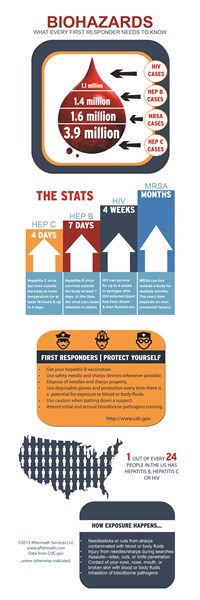AURORA, Ill., Sept. 23, 2013 (GLOBE NEWSWIRE) -- When a law enforcement agent arrives at the scene of a crime, suicide or unattended death, the state of emergency can make them vulnerable to health threats from exposure to blood or other bodily fluids. Considering that one out of every 24 people has Hepatitis B, Hepatitis C or HIV, it is imperative that first responders are continuously educated about the health risks they are exposed to, their right to safety on the job and the responsibilities of their employers to preserve their safety.
A photo accompanying this release is available at http://www.globenewswire.com/newsroom/prs/?pkgid=21112
Aftermath, the only national company specializing in biohazard situations such as crime scene cleanup, has launched a public awareness campaign for law enforcement agencies and other first responder groups, to help educate first responders so they are properly protected from bloodborne pathogens.
"We understand the dangers that first responders are exposed to because our technicians perform biohazard cleaning immediately after the authorities leave," said Tim Reifsteck, co-founder of Aftermath. "But the difference is that our employees are outfitted from head to toe in sealed, protective suits and are experts when it comes to maintaining safety around contaminated materials. Our goal is to continuously share our knowledge and help ensure the highest level of safety for our nation's first responders."
According to Aftermath, some of the key facts for first responders and their employers to remember about handling biohazards include:
- The Hepatitis B virus can survive outside the body for at least a week and can still cause infection in the body of an otherwise-uninfected person.
- MRSA can live outside a person's body for multiple months, depending on environmental factors such as humidity.
- Anyone with a risk of occupational exposure to blood or biological materials has the right to free Hepatitis B vaccination series and personal protective equipment (paid by the employer).
- OSHA requires annual training provided by employers for those who come into contact with bloodborne pathogens.
- Public enforcement agencies whose officers and employees are exposed to blood and biological materials in the course of their employment need to develop and annually update an exposure plan that outlines safety measures in dealing with bio materials.
Law enforcement agencies looking to create or enhance their biohazard training programs can visit www.aftermath.com/staysafe for access to free educational materials, break room posters and other resources.
"Law enforcement officials are among the highest risk individuals for exposure to biohazards through investigating crime scenes, exchanges with individuals with open wounds and spitting and biting incidents. They can also create cross-contamination situations themselves without realizing it," said Reifsteck. "We work closely with many management offices around the country to provide safety advice and education in all these difference scenarios."
About Aftermath
Aftermath Services LLC is the only national company in the U.S. specializing in biohazard remediation. The company's primary mission is to provide families and property owners with compassionate assistance during a time of tragedy. For more than 16 years, Aftermath has pioneered a sophisticated, science-based approach to remediation that protects the health and safety of people and restores property after tragedies such as suicides, murders, mass casualty incidents, unattended natural deaths and industrial accidents. The company was founded in 1996 when two friends offered to help a neighbor's family in a suicide cleanup process and recognized the need to assist other families in similar traumatic situations. For more information about Aftermath, visit www.aftermath.com or call (800) 366-9923 for an emergency dispatch.
